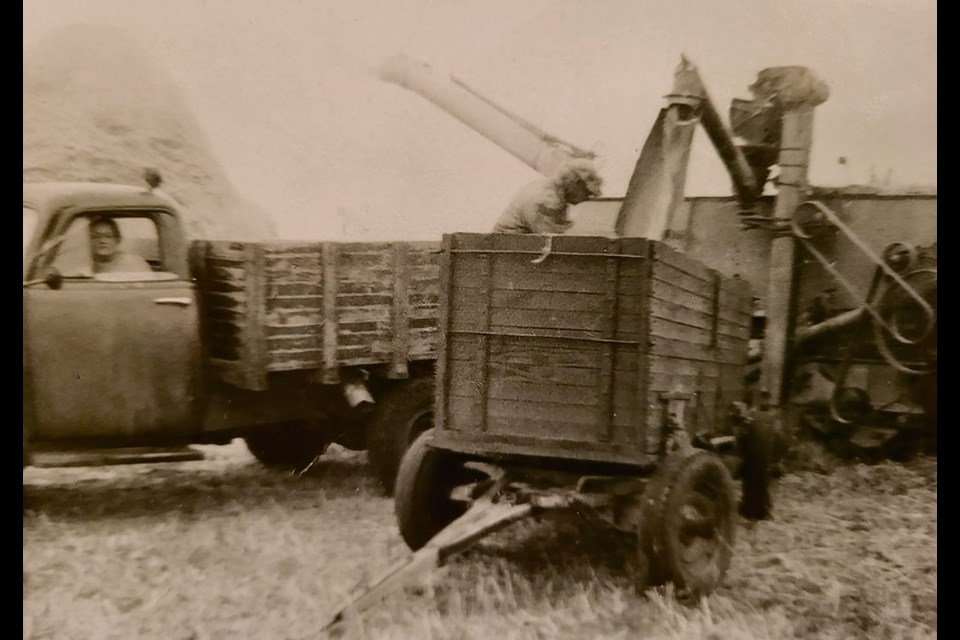CRAIK, Sask. — The first subscription to The Western Producer that Chris Heathcote remembers his household purchasing wasn’t with cash or cheque.
“The first subscription for the paper was paid for by six laying hens,” Heathcote said about getting the Producer at his Craik, Sask., farmhouse 85 years ago.
“That was in the Thirties, and we didn’t have cash.”
The Dust Bowl era still holds a place in the memory of the 92-year-old, who is retired but still takes his hand behind the wheel of a combine on occasion come harvest time.
“I took off my last crop at 85,” said Heathcote.
Bartering with the local Producer subscription salesman for a subscription wasn’t the only thing that was different in a time when going cashless had a whole different meaning than today.
“I was born on the farm in February, and of course my father had to go to town with the horse and buggy to get the doctor because there was no phone,” said Heathcote.
“What a change from today when everybody has a phone in their pocket.”
He read the Producer cover to cover until moving into town, by which time the focus on huge farms, expensive equipment and big, multinational companies had left his generation behind.
“I just don’t know where we’re heading with all this bigger, high-priced equipment — a combine today over $1 million. The first binder I bought was $24,” said Heathcote.
“It’s going to conglomerate farms. One farmer will have 66 quarter sections of land and no little guys, and that’s why all our little towns are dying out.”
However, some of those changes in agriculture have been for the better when it comes to protecting soil.
“Farming has changed so much. We don’t disturb the soil like we used to. We used to go out and plow it and if you had a weed in your field, you had to have it cut off,” said Heathcote.
“Today, it’s different. We leave all of the trash up to protect the land. We grow more wheat now, and we had more rain in the Thirties than what we’ve had lately.”
Tough as the Dust Bowl was for Heathcote and his family, it was also seared into his memory, for better and worse.
“One time Dad was waiting for the milk cows to come up and they wouldn’t come because the neighbour’s field was drifting and it cut off Dad’s field of wheat, and the wheat blew off into the pasture and the cows were eating the wheat because it was cut off from the drifting sand,” Heathcote said.
But he also remembers the sense of community.
“Thrashing time, you got three or four neighbours together, one farmer working the thrashing machine, and everybody else brought a team of horses out and thrashed,” he said.
Jean Hannan, Heathcote’s daughter, said growing up on her father’s farm was different, tougher in many ways, but it had its charms.
“They had everything. The beef from cattle, chickens, pigs, milk cows, grain, the whole thing,” said 65-year-old Hannan.
“You learn how to work. That’s a definite plus. And in whatever job or vocation you’re going to take up, you learn how to work and how to work together with other people and work as a team.”
Chores such as carrying water for the livestock up a hill, clearing rocks, not having running water in the house and then school on top of that wasn’t an easy life, said Hannan.
But it did have its rewards.
“You learn respect and the value of a dollar,” she said.
“Mom sold cream to the creamery, sold eggs, butchered chickens and sold them, had a garden and we just lived off the farm.”
But now an off-farm job is needed to support the operation, she added.
The farm was started by Heathcote’s father and has remained in the family, but it skipped a couple of generations now that great-grandson Walker Boyd is working the farm.
“It’s not the standard five generation farm,” said Boyd.
“But it’s the same yard my grandmother grew up in and house she was born in, so there is a lot of sentimental value.”
However, it’s a far different operation now with the focus on grain rather than a mixed operation.
The 25-year-old said a lot has changed since his great-grandfather’s time, but “it’s different times nowadays.… There is a lot more to it than putting a seed in the ground and watching it grow. There’s a lot more science and technology that goes into it. It’s not like the 1960s or ’80s. You’re asking a lot more out of every acre.”
Things are getting bigger because costs are continuing to rise, making it difficult to contemplate a small mixed operation.
“There’s more 10,000-acre farms out there than 1,000-acre farms,” said Boyd.
“When it comes to land, you are only going to see one title change in a lifetime. It’s one of those things that is becoming harder and harder to come by, and they are not making any more of it.”
There are also expectations that land will be used in the most efficient way to feed an ever-growing population.
But while Heathcote doesn’t think there is any turning back to the old ways, the new way of farming is something he would have never imagined in his heyday.
“It is far more complicated now. Anytime you have an air seeder going down the field and it’s controlled by a satellite to put down what fertilizer you need per acre, on this acre or that acre, I’ve never heard tell of such a stuff but that’s what’s happening,” he said.
“Nothing is the same.”
Bookmark SASKTODAY.ca, Saskatchewan's home page, at this link.




